CT
Computed Tomography (CT) is a fast diagnostic exam used to obtain detailed, visual information on just about any body organ – the liver, pancreas, intestines, kidneys, adrenal glands, lungs and heart. The latest generation of CT – a multi-slice CT scan –is a sophisticated x-ray that produces a scan 100 times more sensitive than conventional x-rays.
Physicians believe that the highly detailed CT images of a 64-slice scanner could eventually replace traditional more invasive diagnostic procedures currently used for screening for colon and heart disease. For example, with the fastest gantry rotation speed available, the 64-slice CT produces images of the entire chest in just 20 seconds. Information from just a single scan can be used to assess the status and function of coronary arteries, including plaque evaluation and stent patency. Traditionally those assessments required an invasive procedure such as heart catheterization, or an angiogram. Similarly, images of the abdomen can be reformatted using a technique called “virtual colonoscopy” to detect precancerous intestinal polyps. What Does it Mean for Patients?
For patients, this powerful imaging equipment all means three-dimensional detail in less than one-third of a second, increasing the potential for faster and less invasive diagnostic procedures.
- Faster, more comfortable scans
- Unparalleled image clarity for a more accurate diagnosis
- 64 scans slices per rotation for better image quality without an increase in x-ray dose
- The industry’s finest CT resolution for detailed images of even the smallest structures
Staying on the cutting edge of CT technology enables us to leverage superior images for a more accurate diagnosis. And an earlier, more accurate diagnose for you means more complete recovery and better health.
SOMATOM Sensation 64-Slice CT Scanner
This technology provides the industry’s finest image quality of even the smallest anatomy. It takes up to 192 pictures per second without an increase in x-ray exposure. For patients, that means safety, unparalleled image clarity, and a more accurate diagnosis. Preparing for the exam takes more time than the scan itself. The typical exam takes less than one minute.

